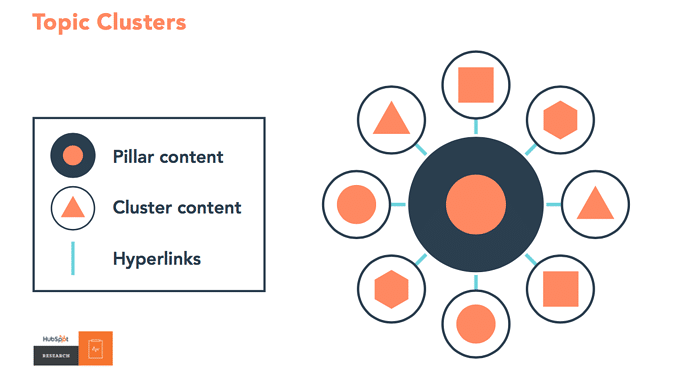Digital Marketing is an ever-changing field.
Technologies emerge at a rapid pace that change the configuration and possibilities of dialogue between a brand and its audience.
Companies and marketers need to be always up to date with the latest ways to achieve better results in such a competitive scenario.
Do you consider what you are doing for your strategy?
In terms of Content Marketing and Search Engine Optimization (SEO), some of the biggest changes today are in the way people search and interact with content, and how the search engine reads and selects this content.
In this context of change, some new concepts and practices have developed, and among them are topic clusters.
If you are not familiar with this idea, this blog will show you everything you need to know to understand the impact of topic clusters.
What are Topic Clusters?
Topic clusters are a form of content organization created by HubSpot from observing how online searches are done and how search engines respond to those queries.
As the name suggests, topic clusters are groups of content that are organized into clusters surrounding a main topic.
Before we dive deeper into how this structure works, it is fundamental to understand how topic clusters have become an important element in SEO strategies.
Why Did Topic Clusters Emerge as the Future of SEO?
The way in which people conduct searches is constantly evolving.
While it has never been cast in stone, the way information was provided by Google a few years ago required searches to be very specific, and results varied according to the typed words.
Today, however, changes in search engines — and even the way we relate to the Internet — mean that search results are more oriented to the user’s search intent.
This translates to being more human when communicating with machines.
Before, this possibility was questionable and proved to be difficult. But, the future promises to be more integrated between machines and humans, especially in regards to SEO.
It is no wonder that Google has been investing more in voice searches, which are made in a more conversational way, and that this is one of the biggest SEO trends for the coming years.
Of course, in this scenario, it becomes necessary to understand and respond to the user’s search intent to achieve good rankings on the Search Engine Results Page (SERP).
If we can interact more with the search engine, the ideal scenario is that we can naturally submit various types of search (as if we were speaking directly to someone) and that the search engine answers us back, also in the most natural way expected.
So, what does this have to do with topic clusters? Everything!
The fact is that you can no longer focus only on keywords.
➤ Although they are essential elements for good content development and ranking, you will not achieve good positions if you create content thinking about them only.
This is why it is necessary to provide context; this is the purpose of topic clusters.
By contextualizing related topics and adding internal links consistently, the idea is to show the search engine that you have the best possible content to offer the user.
But how does this happen in practice?
How Do Topic Clusters Work?
Topic clusters are an organized structure, so they should be planned to:
- Understand what is being done.
- Have an overview of the strategy
- Consistently measure the results.
To put it simply, a topic cluster has three main elements: pillar content, cluster content and hyperlinks.

This organized web of content will show the search engine the relevance of your pages, optimize your search engine results, and play an important role in your SEO strategy.
Next, we will see how to define the pillars and clusters, add hyperlinks and structure a topic cluster.
Structuring a Topic Cluster
Remember the three main elements? Let’s take a closer look at them.
Pillar content
The pillar content is the center of a content cluster.
As the name implies, it serves as the fundamental support structure for a cluster to work.
But how do you define which article will be the pillar of a content group?
The general rule is that the pillar content should comprehensively cover a topic.
In practice, this means that the pillar post will be built around a keyword that usually refers to a broader subject.
Although there is a tendency that, in most cases, these keywords will end up being head-tails and top-of-funnel keywords, it is important not to mix up definitions and think that a pillar post will always follow this pattern.
In addition, the pillar content must be highly relevant to your ranking and conversion strategies, addressing essential topics for your company that are directly linked to your business goals.
Example of a pillar content
If we take Rock Content as an example, we can think of one of the central pillars as “Content Marketing”.
Notice how this is a topic that has relevance to the strategy, the business, and the company’s sales funnel.
So the pillar post refers to how important a topic is to your company and how much you intend to work on it.
It may be that the pillar is relevant for you, but not for other strategies.
It is important to do this preliminary analysis of which topics are most important and which deserve to be at the center of your content and optimization efforts.
When choosing a topic, it is also important to consider the ability of that content to broadly address the questions of users who searched for that term and, in addition, to address other various subjects internally, serving as a basis for further content.
A good tip is that more specific themes, which generally deal with long-tail keywords, don’t make good pillar posts.
Even though they are very important for your strategy, they cannot be a pillar because they do not provide a range of subjects wide enough to support other articles.
Cluster content
If you have defined your pillar, the next step is to think about the content that aligns with your definition.
This refers to the group of content that will work together to turn your pillar into a relevant page for the search engine and then appear among the first results of the SERP.
While pillars deal with broader topics, clusters can (and often should) be more specific.
But again, it is important to be careful.
Don’t think that this means that it’s content for the middle or bottom of the funnel, although there is that tendency.
When defining your clusters, they must be addressed precisely and specifically, without exploring other subjects too much, as is the case with the pillar.
Cluster content should commit to a specific subject and address it as thoroughly as possible.
If possible, pillar content must reference and explore, even briefly, all of the clusters.
In general, for each pillar post, 10 to 30 cluster posts should support it, although there is no set rule around this number.
Example of a cluster content
Going back to the Rock Content example and considering “Content Marketing” as the pillar content, we can think of some possible cluster posts, such as:
- Content marketing examples
- Content marketing software
- Content marketing strategy
- Content marketing metrics
- Content marketing trends
- Content marketing KPIs
- Editorial calendar
- Growth hacking
- Buyer persona
- Copywriting
And so on.
To discover your clusters, we suggest you do some keyword research and find those that can be included in your content.
After producing the materials, it’s time to link them.
The pillar and its clusters must be interconnected to show the search engine that they follow an organization and that you have authority on that subject.
This interconnection must be made through hyperlinks, which leads us to the next topic.
Hyperlinks
Getting backlinks is one of the major goals of a good SEO strategy. After all, they are one of the most important ranking factors for Google.
However, many professionals forget that internal linking also plays an important role in the success of the strategy.
Although they do not have the same value as external links in terms of ranking, internal links work to show the search engine:
- How your pages are organized.
- Which are the most important.
- And the authority of your company regarding a specific theme.
Thus, in the topic cluster structure, internal links are indispensable.
But it shouldn’t be done carelessly. You must plan these links as follows:
The cluster post should always be linked to its pillar
Although the first link doesn’t need to be to the pillar page, it is recommended.
It is also important to use the exact anchor (i.e., if your pillar is “SEO”, the link must be to this word).
The pillar post must link back to the cluster
When exploring the theme of the cluster in the pillar post, you won’t (and shouldn’t) be able to give as much attention to the topic.
So add a “learn more” button or make a simple anchor for the cluster.
By doing this, you create a web of content around your main post so that it is all connected and signaling its importance as a whole to the search engine.
This structuring work demands organization, and the more posts you have in your strategy, the harder this task becomes.
To help you with this mission, you can rely on online mind map tools such as Coggle or Lucidchart so that you can easily and visually organize your posts and measure the effectiveness of the clusters.
If you prefer to make more detailed documentation of your topic clusters, you can also choose to organize them using a spreadsheet, as in the following image:

Topic Clusters at HubSpot
Remember at the beginning of this article we mentioned that HubSpot conceived the concept of topic clusters?
While this is true, it is also true that this concept already existed in similar forms before.
Rock Content itself uses a strategy of satellite posts.
Although the two concepts are not the same, they aim at achieving better positions for the main post and higher conversions for the strategy as a whole.
And they do this through consistent internal linking and producing content in a planned way.
So, what is HubSpot’s differential?
Well, besides having formalized this differently (for example, in topic clusters, the pillar post tends to be for a head-tail, besides it not being possible to make clusters with content that can be pillars), HubSpot created a tool for organizing the strategy within its platform.
This makes it possible to organize your topic clusters visually, centrally, and automatically.
But the coolest thing is that the company has developed a format to make your analysis much easier!
Much of the manual work of collecting and analyzing data is saved, making it easier to track metrics such as authority, access, and conversions.
This way, you can see the effectiveness of a topic cluster, proving your efforts, identifying optimization points, and working to improve results.
The downside (yes, it always exists) is that this tool is paid.
On the other hand, if you already invest in this software, we strongly recommend using it to optimize your content strategy.
Wrap Up: Start Incorporating Topic Clusters in Your Strategy
Are you now ready to incorporate topic clusters into your marketing strategy?
This is a sign that you really want topic clusters to bring positive results to your business and your content production.
In order for you to do this, you must become familiar with Search Engine Optimization.
And we have the perfect SEO guide for you to reach top Google results!

![[WA] Ultimate Content Marketing Kit](https://rockcontent.com/wp-content/uploads/2022/08/Content-Marketing-Kit-750x200px.jpg)


![[ROCK NA] [EBOOK SEO] Complete Guide](https://rockcontent.com/wp-content/uploads/2024/06/banner_Search-Engine-Optimization.png)






